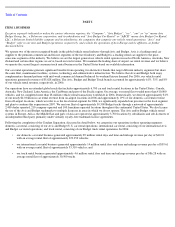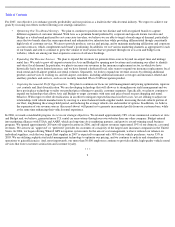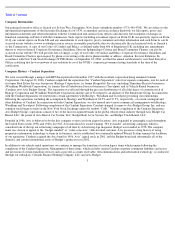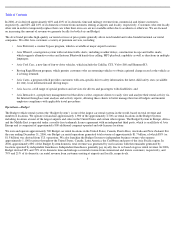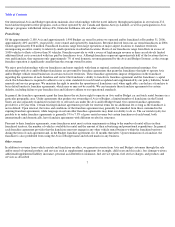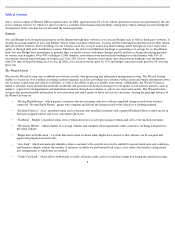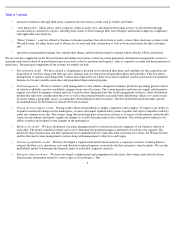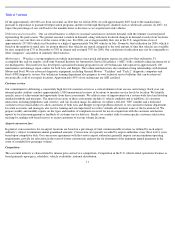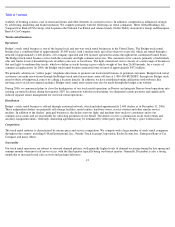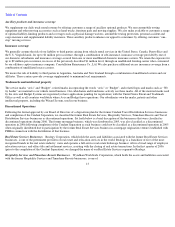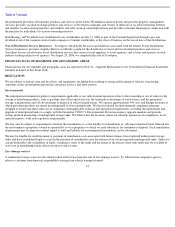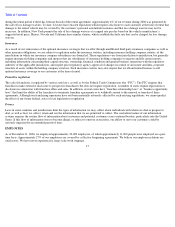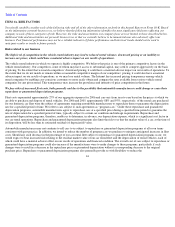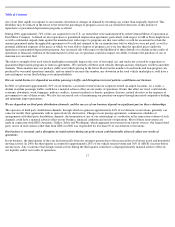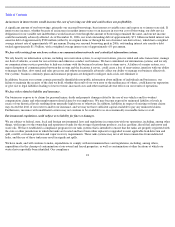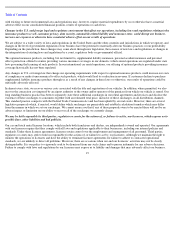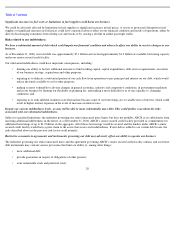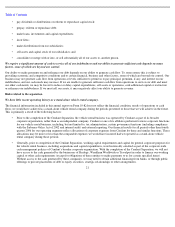Avis 2006 Annual Report Download - page 16
Download and view the complete annual report
Please find page 16 of the 2006 Avis annual report below. You can navigate through the pages in the report by either clicking on the pages listed below, or by using the keyword search tool below to find specific information within the annual report.
Table of Contents
Of the approximately 445,000 cars from our rental car fleet that we sold in 2006, we sold approximately 88% back to the manufacturers
pursuant to repurchase or guaranteed depreciation programs and the rest through third party channels such as wholesale auctions. In 2007, we
expect the percentage of cars sold back to the manufacturers to decrease as we acquire more risk vehicles.
Utilization and seasonality . Our car rental business is subject to seasonal variations in customer demand, with the summer vacation period
representing the peak season. The general seasonal variation in demand, along with more localized changes in demand at each of our locations,
causes us to vary our fleet size over the course of the year. For 2006, our average monthly fleet size in the U.S. ranged from a low of
approximately 297,000 vehicles in December to a high of approximately 366,000 vehicles in July. Domestic fleet utilization for 2006, which is
based on the number of rental days (or portion thereof) that vehicles are rented compared to the total amount of time that vehicles are available
for rent, ranged from 67% in December to 78% in August and averaged 75% for 2006. Our calculation of utilization may not be comparable to
other companies’ calculation of similarly titled statistics.
Maintenance
. We place a strong emphasis on vehicle maintenance since quick and proper repairs are critical to fleet utilization. To
accomplish this task we employ a full-time National Institute for Automotive Service Excellence (“ASE”)
fully certified technician instructor at
our headquarters. This instructor has developed a specialized training program for our 410 technicians who operate in approximately 100
maintenance and damage repair centers for both Avis and Budget. The technicians/instructors also maintain strong relationships with General
Motors and Ford. We use advanced diagnostic equipment, including General Motors’ “Techline” and “Tech 2” diagnostic computers and
Ford’s PDS diagnostic system. Our technician training department also prepares its own technical service bulletins that can be retrieved
electronically at all of our repair locations. Approximately 89% of our technicians are ASE certified.
Customer service
Our commitment to delivering a consistently high level of customer service is a critical element of our success and strategy. Each year, our
internal quality auditors conduct approximately 1,000 unannounced reviews of locations to measure service levels by location. We identify
specific areas of achievement and opportunity from these assessments. We address areas of improvement on a system-wide level and develop
standard methods and measures. The major focus areas of these assessments include (i) vehicle condition and availability; (ii) customer
interaction, including helpfulness and courtesy; and (iii) location image. In addition, we utilize a toll-free “800” number and a dedicated
customer service email address to allow customers of both Avis and Budget to report problems directly to our customer relations department.
Location associates and managers also receive training and are empowered to resolve virtually all customer issues at the location level. We
prepare weekly and monthly reports on the types and number of complaints received for use in conjunction with the customer satisfaction
reports by location management as feedback of customer service delivery. Finally, we conduct daily location-specific customer satisfaction
tracking by sending web-based surveys to recent customers of our top volume locations.
Airport concession fees
In general, concession fees for on-airport locations are based on a percentage of total commissionable revenue (as defined by each airport
authority), subject to minimum annual guaranteed amounts. Concessions are typically awarded by airport authorities every three to five years
based upon competitive bids. Our concession agreements with the various airport authorities generally impose certain minimum operating
requirements, provide for relocation in the event of future construction and provide for abatement of the minimum annual guarantee in the
event of extended low passenger volume.
Competition
The car rental industry is characterized by intense price and service competition. Competition in the U.S. vehicle rental operations business is
based primarily upon price, reliability, vehicle availability, national distribution,
11


